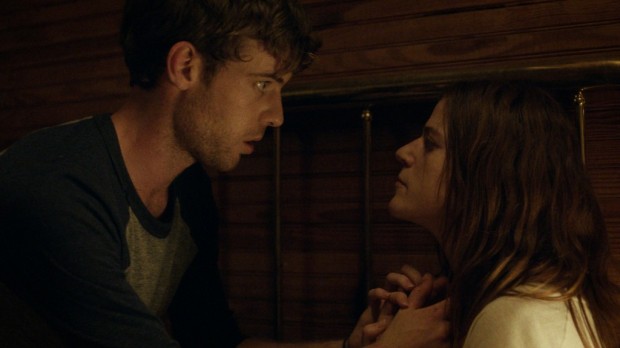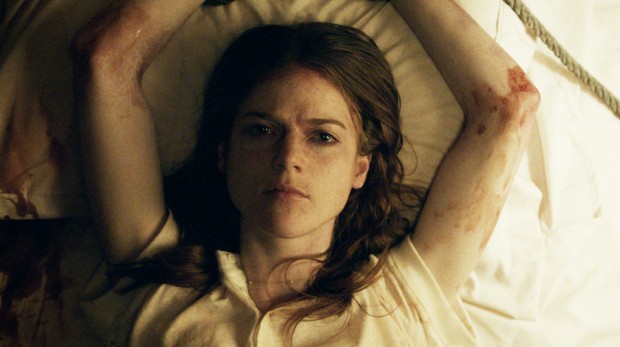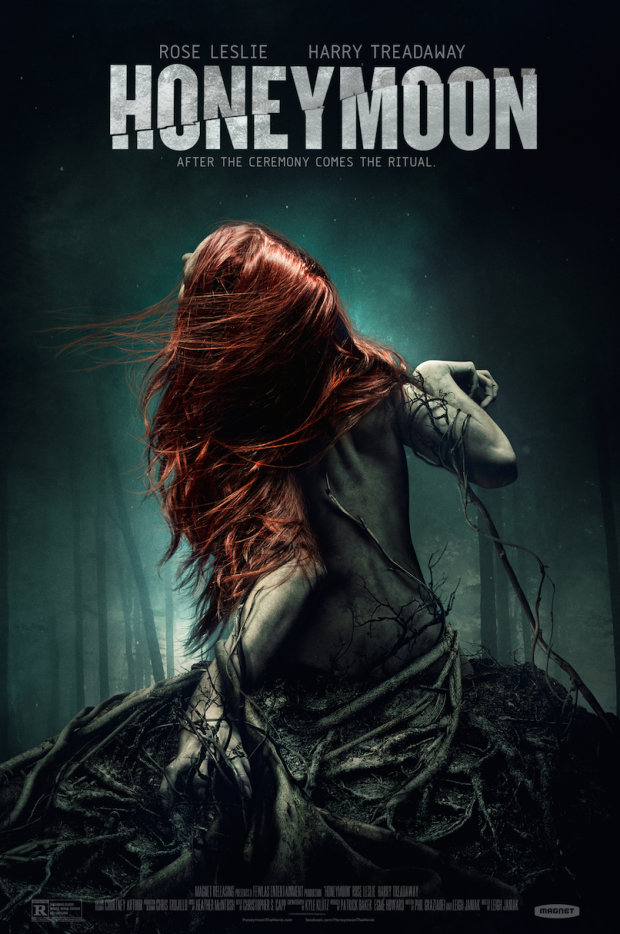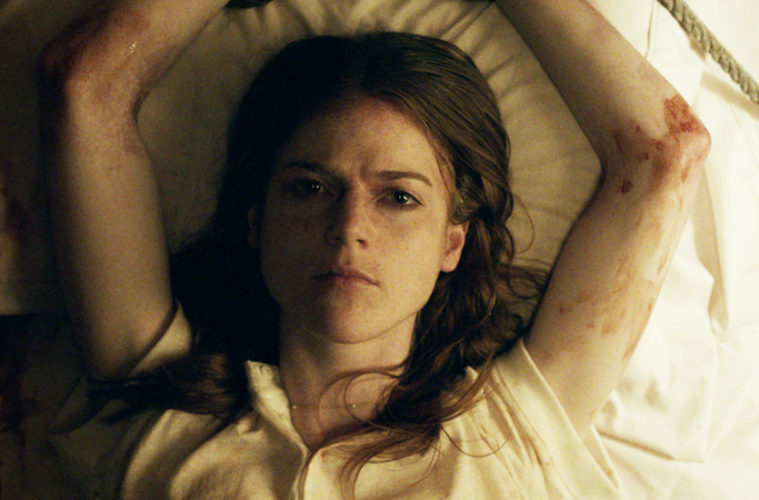
Honeymoon doesn’t mind playing it slow nor low-key. Co-written by Leigh Janiak, who is making her directorial debut, this mishmash of genres is more interested in the characters of the story than your expectations of just what a horror/thriller/sci-fi/romance might entail. Starring Rose Leslie of Game of Thrones fame, with support from Harry Treadaway, Honeymoon, which is in limited release this weekend, keeps its focus narrow and sharp. Identity is the examination here, asking just what makes us who we are? What if that line was blurred?
I recently had the chance to chat with Janiak on the phone about her debut and just what her goals were. Among the topics we covered was her mentality in terms of pushing the budget, a scary and hilarious story about her boyfriend’s twin, which classics influenced her debut, how her time at various movie production companies helped guide her career, and why she is so fascinated with bodies. We also delve into some significant spoilers near the end but I’ve made mention of them in plain text so you can avoid those easily. Read on for the full interview.
The Film Stage: So you worked for a production company for a number of years. You were writing scripts on the side but you were obviously reading a lot of scripts as well for them. What kind of insight did that give you into what was being made? You seem to specifically be interested in genre film, at least that’s what you’ve said in numerous interviews. Did that translate to genre films?
Leigh Janiak: Well, it’s interesting. I started working in LA at Leonardo DiCaprio’s production company and I worked there for a year. I then I moved to another production company called Mischer Films. That was run by someone that used to run Universal. I was there for about five years, which was right up until I left to do full time development on Honeymoon. Neither of those companies really deals in a genre space at all. So most of my experience… it was certainly invaluable and a lot of it came from understanding the other side of things. It was a creative position and those are creative production companies. That’s how they develop scripts and then get them to screens. But it was more business oriented so I feel like I got a good grasp of the studio side of things. Knowing when the producer is saying this to the director, this is what they actually mean. That sort of thing. As for the scripts, it was really understanding that you’re trying to make these movies within the studio system. It’s not a formula but the confines you can really work in are smaller than the independent space.
Absolutely. In a couple of interviews you’ve mentioned that you don’t have to worry about foreign box office and sales, the market that that’s going to bring. It’s just like, “I just want to make a small movie.”
Yeah, and I think if you’re making a small movie part of the fun and joy of it is that you get to do what you want to do. You don’t have to put things in specific boxes. I think I was very lucky with Honeymoon because the budget level was at a place where we didn’t have to depend on foreign presales. I had the support of my producers, Patrick Baker and Esme Howard, who really just said, “Listen, we believe in your script and your vision and we’re going to support that.” So we were really able to make this weird genre thriller scifi horror romance thing and I feel really lucky for that.

You’ve mentioned before that you’re a big fan of genre stuff, sci-fi and horror. But this film kind of treads a very fine line between genres. It doesn’t lean too heavily to one side of things. Was that a budgetary constraint or was that grey area somewhere you were interested in playing?
For me, it was about living in that grey area. For me, the scariest horror movie and the scariest sci-fi stuff is the stuff that’s based in reality in some way. I always talk about Rosemary’s Baby or even The Shining are good examples where you start with their characters and you get into their space. Because you’re tied to such an intimate point of view, when it starts to become horrific or more science fiction-like you can appreciate it more. At least for me as a viewer. So that’s what I was playing with. I wanted everything to stem from Paul and Bea’s relationship and really just watch these people get torn apart. Whatever trauma there is, I think that that is what really drove me. And I was very excited and happy to get this place of more body horror at the end.
I know you shot in North Carolina and mainly in one single location. So you saved money in both of those instances. You also pull off some clever tricks visually to tell but not show. And this is a small budget film. So where do you push your budget? Do you go after more days?
That’s exactly the area. I would say we had a good schedule, as far as indie movies go. We had 24 days. A lot of them are 18 or 19 days. So 24 days was important to me because so much of the movie holds on performance and the chemistry between Rose and Harry. I felt that having the time to support them so that they were really able to get into that space. We were not a two take-and-move-on movie, specifically so we could get to that more authentic place in their relationship. And also, some of the effects we did with like the light beam, those were certainly… if we had shot in LA it would have been way easier. We would have had a bigger support crew and in this case we brought a lot of our grips and electrics from LA and we had support in North Carolina but you’re kind of isolated in the middle of the woods. If a piece of equipment needs to be changed it doesn’t just happen as quickly as it would in LA. I feel like we were so lucky that my key grip, who is named Jose Cruz, he was awesome and he just rigged amazing things. But a lot of that, it’s just you’re in the middle of the woods. Things becomes more difficult and expensive because we’re bringing things from further away. But yeah, I’d say mostly just days and a few of those special effects things because we had to bring it out.
I know that you found Rose first and then you found Harry. And I’ve got to share something with you because I was reading up on this film and I kept thinking Harry looked familiar.
[Laughs]
I had seen him before. So of course I looked him up on IMDB and I was like, “No, I guess he’s not that guy I’m thinking of.”
[Laughs]
But it turns out it is actually Luke that I was thinking of, his brother, who was great in Attack the Block, which I love so much. It’s so funny that you had mentioned them together in an interview because as soon as I saw Harry I just had a familiar feeling with him. It’s interesting that they’re both working in this genre space now. Are they twins?
Yeah, so they’re identical twins. Well, I believe. I mean, they look exactly the same. I don’t know if they’re technically identical or just fraternal. But it was interesting to me because my boyfriend is a film maker and he’s also a twin. And he writes and directs with his twin. And a lot of development of Honeymoon was understanding and thinking about identity. I had this one moment when I was on set for my boyfriend’s film and I woke up early in the morning and I didn’t have my glasses on. We were up in Vancouver and I ran my hand down his back and he turned around it was his twin!
[Both laugh].
It was the worst feeling, ever. It was terrible. He was disgusted. I was disgusted. It was a pretty benign interaction but the familiarity with which I touched him was just too much. I think that I was actually kind of excited when, I mean I knew Harry was a twin because I had seen Brothers of the Head, which by the way if you haven’t seen you should check out because it’s crazy. Him and Luke play conjoined twins. But I liked this idea that, and Harry lives in a space where he’d probably be like, “I never think about it.” But for me, I feel like being a twin makes you have to think about identity more than just a normal, singular person walking around. I kind of love that that was in there. And I literally never spoke to him about it but secretly I was like, “This is good.”

It’s so funny that you had that experience because there’s a scene in the film where Paul is looking at Bea’s feet and he’s recognizing down to the minute details. I was curious where that came from because it seems like such an interesting thing to hone in on. A lot of time these kinds of interactions in films end up focusing on the face or the eyes. He starts at the lowest extremity he can find.
I think I’ve just thought a lot about bodies. [Laughs]. What makes you, you. I think I’ve always been fascinated by that idea about where is the self. Where do you exist? If I changed my hair color, I’m obviously still me. If I put color contacts in, I’m still me. If I cut off my hand, I’m still me. So how many pieces can we cut away before you’re like, “It’s not you anymore. Where have you gone?” I think it’s that mind-body kind of dichotomy and in this space it was Harry’s character Paul thinks he knows everything about Bea. Every little detail of his lover’s body. He’s so confused by that intangible thing that has changed and he’s trying to understand it and get to that point and it’s not adding up.
SPOILERS AHEAD
One thing I really wanted to get into, and we’re talking about spoilers here, is the alien design and the creatures themselves. They’re always in silhouette. The only thing I really noticed were the fingers or talons, whatever you want to call them. So I’m curious how much of the alien design you went after. Did you design it to the point where it looked good in light or were you mainly focusing on just the silhouette version since that’s all that was shown? And of course there is the creature that he pulls out of her, which is just awesome.
[Laughs]. Well, that design certainly was something that we had to build from the ground up with my awesome special effects makeup artist, Christopher Allen Nelson. I always knew that that would be shown in the light and for me that was because that was part of Bea and her transformation. The central focus of the film for me was their relationship. So I didn’t want the alien creature design outside of that to overwhelm what I thought was the central focus of the film. So it was twofold. I was worried that if you started seeing too much of the alien you’d want to know more about them and feel like you should be more concerned about what they are. What are the specifics of their plan? It becomes a different movie. And also of concern was budget. We didn’t have a lot of money for VFX and I knew that we could never execute a creature design that I would feel satisfied with as an audience member so for me, thematically it made sense, to keep them silhouetted. We used this camera attachment called the “Lens Baby” to give the distortion effect when we’re in her point of view, looking at them. Essentially, any kind of artwork we did for them was always basically something based on someone suffering from Marfan syndrome. That body type is very elongated with long fingers. And yes, as dark as we could make it so you felt like they were almost like black holes in themselves.
Honeymoon hits limited release and VOD on Friday, September 12th.

